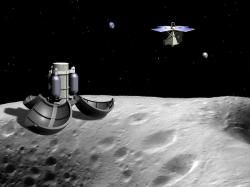Feb 28, 2007
Lasers to detect and deflect asteroids
Posted by Brian Wang in categories: asteroid/comet impacts, defense, existential risks, lifeboat, space
Graduate student (University of Alabama Huntsville) Blake Anderton wrote his master’s thesis on “Application of Mode-locked lasers to asteroid characterization and mitigation.” Undergraduate Gordon Aiken won a prize at a recent student conference for his poster and presentation “Space positioned LIDAR system for characterization and mitigation of Near Earth Objects.” And members of the group are building a laser system “that is the grandfather of the laser that will push the asteroids,” Fork said.
Anderton’s mode locked lasers could characterize asteroids up to 1 AU away (1.5 × 10 to the 11 meters). Arecibo and other radar observatories can only detect objects up to 0.1 AU away, so in theory a laser would represent a vast improvement over radar.
A one page powerpoint describes their asteroid detection and deflection approach About 12 of the 1AU detection volumes (around the sun in the asteroid belt) would be needed to cover the main areas for near earth asteroids.
40KW femtosecond lasers could deflect an asteroid the size of Apophis (320meters, would hit with 880 megaton force) given one year of illumination and an early start in the trajectory.









